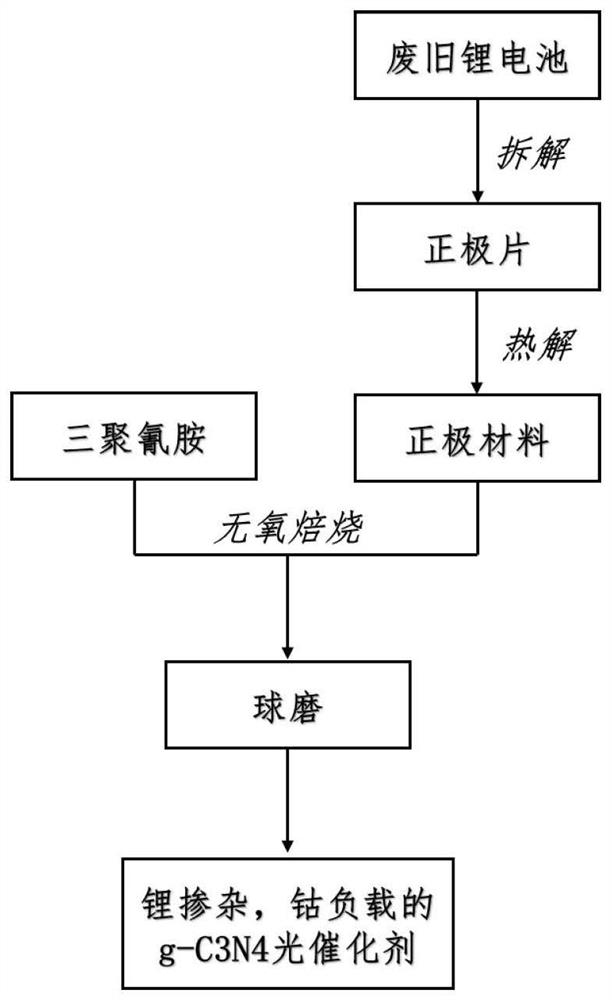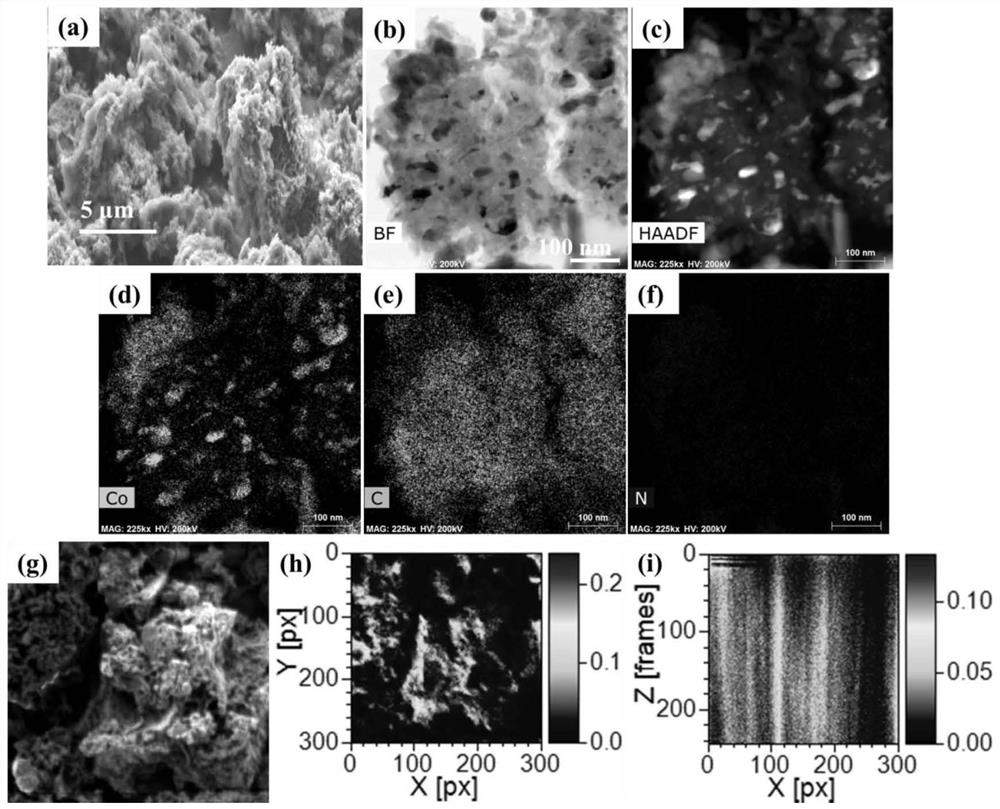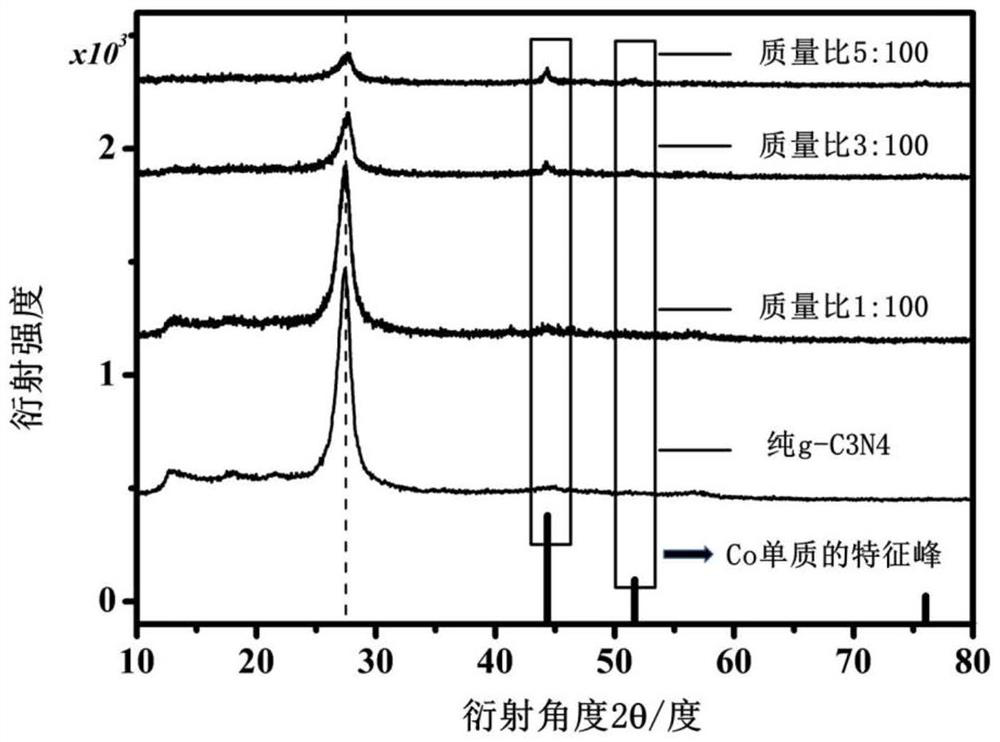Method for preparing lithium-doped and cobalt-loaded g-C3N4 photocatalyst
A photocatalyst, g-c3n4 technology, applied in chemical instruments and methods, physical/chemical process catalysts, chemical/physical processes, etc., can solve problems such as abandoning residual value, enhance photocatalytic performance, realize added value utilization, The effect of avoiding the use of high-purity metal salts
- Summary
- Abstract
- Description
- Claims
- Application Information
AI Technical Summary
Problems solved by technology
Method used
Image
Examples
Embodiment 1
[0024] This embodiment provides a method for preparing lithium-doped, cobalt-supported g-C3N4 photocatalysts, such as figure 1 , including the following steps:
[0025] 1. Disassemble the waste lithium cobalt oxide battery to obtain the positive electrode sheet, and then vacuum pyrolyze the positive electrode sheet at 450°C for 30 minutes to remove the binder to obtain the lithium cobalt oxide positive electrode material;
[0026] 2. Uniformly mix the obtained lithium cobalt oxide cathode material with melamine at a mass ratio of 3:100, and then perform anaerobic calcination. The nitrogen flow rate was controlled to 50ml / min, the heating rate was 5°C / min, the reaction temperature was 600°C, and the reaction time was 2h.
[0027] 3. The residue after the reaction was treated by ball milling to obtain the photocatalyst. The ball milling conditions were as follows: the rotation speed was 2000 rpm, and the reaction time was 1 h.
Embodiment 2
[0029] This embodiment provides a method for preparing lithium-doped, cobalt-supported g-C3N4 photocatalysts, such as figure 1 , including the following steps:
[0030] 1. Disassemble the waste lithium cobalt oxide battery to obtain the positive electrode sheet, and then vacuum pyrolyze the positive electrode sheet at 450°C for 30 minutes to remove the binder to obtain the lithium cobalt oxide positive electrode material.
[0031] 2. Mix the obtained lithium cobalt oxide cathode material with melamine uniformly at a ratio of 3:100, and then perform anaerobic calcination. The flow rate of argon gas is controlled to 100ml / min, the heating rate is 2°C / min, the reaction temperature is 550°C, and the reaction time is 2h.
[0032] 3. The residue after the reaction was treated by ball milling to obtain the photocatalyst. The ball milling conditions were as follows: the rotation speed was 2000 rpm, and the reaction time was 1 h.
Embodiment 3
[0034] This embodiment provides a method for preparing lithium-doped, cobalt-supported g-C3N4 photocatalysts, such as figure 1 , including the following steps:
[0035] 1. Disassemble the waste lithium cobalt oxide battery to obtain the positive electrode sheet, and then vacuum pyrolyze the positive electrode sheet at 450°C for 30 minutes to remove the binder to obtain the lithium cobalt oxide positive electrode material;
[0036] 2. Mix the obtained lithium cobalt oxide cathode material with melamine uniformly at a ratio of 3:100, and then perform anaerobic calcination. Control the argon flow rate to 100ml / min, the heating rate to 4°C / min, the reaction temperature to 650°C, and the reaction time to 0.5h;
[0037] 3. The residue after the reaction was treated by ball milling to obtain the photocatalyst. The ball milling conditions were as follows: the rotation speed was 2000 rpm, and the reaction time was 1 h.
PUM
 Login to View More
Login to View More Abstract
Description
Claims
Application Information
 Login to View More
Login to View More - R&D
- Intellectual Property
- Life Sciences
- Materials
- Tech Scout
- Unparalleled Data Quality
- Higher Quality Content
- 60% Fewer Hallucinations
Browse by: Latest US Patents, China's latest patents, Technical Efficacy Thesaurus, Application Domain, Technology Topic, Popular Technical Reports.
© 2025 PatSnap. All rights reserved.Legal|Privacy policy|Modern Slavery Act Transparency Statement|Sitemap|About US| Contact US: help@patsnap.com



